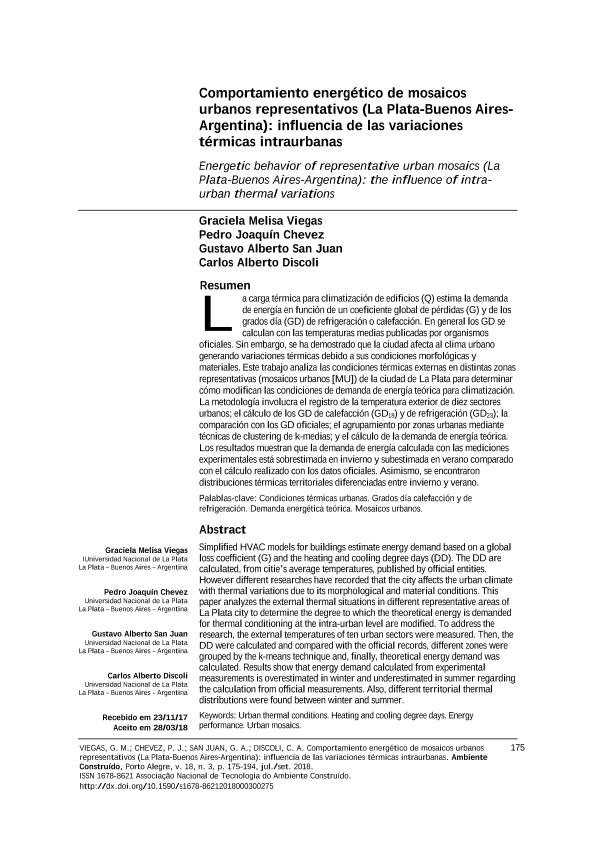Mostrar el registro sencillo del ítem
dc.contributor.author
Viegas, Graciela Melisa

dc.contributor.author
Chevez, Pedro Joaquín

dc.contributor.author
San Juan, Gustavo Alberto

dc.contributor.author
Discoli, Carlos Alberto

dc.date.available
2019-09-23T19:50:54Z
dc.date.issued
2018-07
dc.identifier.citation
Viegas, Graciela Melisa; Chevez, Pedro Joaquín; San Juan, Gustavo Alberto; Discoli, Carlos Alberto; Comportamiento energético de mosaicos urbanos representativos (La Plata-Buenos Aires-Argentina): influencia de las variaciones térmicas intraurbanas; Associação Nacional de Tecnologia do Ambiente Construído; Ambiente Construido; 18; 3; 7-2018; 175-194
dc.identifier.issn
1415-8876
dc.identifier.uri
http://hdl.handle.net/11336/84192
dc.description.abstract
Los modelos de cálculo de carga térmica simplificados para climatización de edificios estiman la demanda en función de un coeficiente global de pérdidas (G) y de los grados día (GD) de refrigeración o calefacción. Los GD son calculados a partir de temperaturas promedio de las ciudades, publicadas por el Servicio Meteorológico Nacional. Sin embargo distintas investigaciones han registrado que la ciudad afecta al clima urbano con variaciones térmicas significativas debido a sus condiciones morfológicas y materiales (artificiales y naturales). Este trabajo analiza las situaciones térmicas externas en distintas zonas representativas de la ciudad de La Plata, capital de la Provincia de Buenos Aires, Argentina, para determinar el grado en que modifican las condiciones de demanda de energía teórica urbana. Los resultados muestran una sobrestimación de la demanda de energía en invierno y una subestimación en verano en varios mosaicos urbanos, respecto del cálculo teórico, obteniéndose diferentes necesidades térmicas en la ciudad analizada. Asimismo, se encontraron distribuciones térmicas diferenciadas entre invierno y verano.
dc.description.abstract
Simplified HVAC models for buildings estimate energy demand based on a global loss coefficient (G) and the heating and cooling degree days (DD). The DD are calculated, from citie's average temperatures, published by official entities. However different researches have recorded that the city affects the urban climate with thermal variations due to its morphological and material conditions. This paper analyzes the external thermal situations in different representative areas of La Plata city to determine the degree to which the theoretical energy is demanded for thermal conditioning at the intra-urban level are modified. To address the research, the external temperatures of ten urban sectors were measured. Then, the DD were calculated and compared with the official records, different zones were grouped by the k-means technique and, finally, theoretical energy demand was calculated. Results show that energy demand calculated from experimental measurements is overestimated in winter and underestimated in summer regarding the calculation from official measurements. Also, different territorial thermal distributions were found between winter and summer.
dc.format
application/pdf
dc.language.iso
spa
dc.publisher
Associação Nacional de Tecnologia do Ambiente Construído
dc.rights
info:eu-repo/semantics/openAccess
dc.rights.uri
https://creativecommons.org/licenses/by/2.5/ar/
dc.subject
CONDICIONES TÉRMICAS URBANAS
dc.subject
GRADOS DÍA CALEFACCIÓN Y DE REFRIGERACIÓN
dc.subject
GRADOS DÍA CALEFACCIÓN Y DE REFRIGERACIÓN
dc.subject
MOSAICOS URBANOS
dc.subject
DEMANDA ENERGÉTICA TEÓRICA
dc.subject.classification
Ingeniería Medioambiental y Geológica, Geotécnicas

dc.subject.classification
Ingeniería del Medio Ambiente

dc.subject.classification
INGENIERÍAS Y TECNOLOGÍAS

dc.title
Comportamiento energético de mosaicos urbanos representativos (La Plata-Buenos Aires-Argentina): influencia de las variaciones térmicas intraurbanas
dc.title
Energetic behavior of representative urban mosaics (La Plata-Buenos Aires-Argentina): the influence of intra-urban thermal variations
dc.type
info:eu-repo/semantics/article
dc.type
info:ar-repo/semantics/artículo
dc.type
info:eu-repo/semantics/publishedVersion
dc.date.updated
2019-09-12T17:26:05Z
dc.identifier.eissn
1678-8621
dc.journal.volume
18
dc.journal.number
3
dc.journal.pagination
175-194
dc.journal.pais
Brasil

dc.journal.ciudad
Puerto Alegre
dc.description.fil
Fil: Viegas, Graciela Melisa. Consejo Nacional de Investigaciones Científicas y Técnicas. Centro Científico Tecnológico Conicet - La Plata; Argentina. Universidad Nacional de La Plata. Facultad de Arquitectura y Urbanismo. Instituto de Investigación y Política del Ambiente Construido; Argentina
dc.description.fil
Fil: Chevez, Pedro Joaquín. Consejo Nacional de Investigaciones Científicas y Técnicas. Centro Científico Tecnológico Conicet - La Plata; Argentina. Universidad Nacional de La Plata. Facultad de Arquitectura y Urbanismo. Instituto de Investigación y Política del Ambiente Construido; Argentina
dc.description.fil
Fil: San Juan, Gustavo Alberto. Consejo Nacional de Investigaciones Científicas y Técnicas. Centro Científico Tecnológico Conicet - La Plata; Argentina. Universidad Nacional de La Plata. Facultad de Arquitectura y Urbanismo. Instituto de Investigación y Política del Ambiente Construido; Argentina
dc.description.fil
Fil: Discoli, Carlos Alberto. Consejo Nacional de Investigaciones Científicas y Técnicas. Centro Científico Tecnológico Conicet - La Plata; Argentina. Universidad Nacional de La Plata. Facultad de Arquitectura y Urbanismo. Instituto de Investigación y Política del Ambiente Construido; Argentina
dc.journal.title
Ambiente Construido

dc.relation.alternativeid
info:eu-repo/semantics/altIdentifier/url/http://ref.scielo.org/yrvdq4
dc.relation.alternativeid
info:eu-repo/semantics/altIdentifier/doi/http://dx.doi.org/10.1590/s1678-86212018000300275
Archivos asociados
